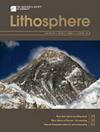中国西北部伊犁块体北缘曲里海岩浆岩的成岩作用和构造影响
IF 1.7
4区 地球科学
Q3 GEOCHEMISTRY & GEOPHYSICS
引用次数: 0
摘要
尽管已经开展了大量的研究工作,但伊犁块体(YB)北缘是否仍是石炭纪早期的活动大陆边缘仍存在争议。在此,我们对伊犁块体北缘的曲里海岩体进行了锆石U-Pb地质年代、地球化学和锆石Lu-Hf同位素研究,以制约其岩石成因和动力过程。曲里海岩体是一个花岗岩复合体,由石英闪长岩、石英单长岩和正长岩组成。锆石U-Pb年代测定结果表明,该岩体形成和喷出的时间介于346至342Ma之间。三种不同的瞿里海岩浆岩的εHf(t)值在+3至+8之间,具有可比性。相应的两阶段模型年龄为817-1182Ma,表明它们可能来自中新生代幼壳。瞿里海岩浆岩的典型特征是 SiO2、K2O 和 Al2O3 含量中高,而 MgO 和 Fe2O3T 含量较低。石英闪长岩和石英单斜岩样品的 Mg# 值为 43-47,表明源区有地幔源熔体输入。相比之下,正长花岗岩的源区则纯粹是地壳物质。瞿理海岩体的主要特征是I型花岗岩系列的强金属铝质中-高-K热碱岩,富含大离子亲岩元素,贫乏高场强元素,同时表现出活跃的大陆边缘岛弧岩浆活动。结合以往研究的综合分析,我们的研究结果表明:曲里海岩体的形成是石炭纪早期天山北麓大洋地壳在YB之下俯冲作用的结果,与俯冲前进向俯冲后退的构造体系转换同时发生。本文章由计算机程序翻译,如有差异,请以英文原文为准。
Petrogenesis and Tectonic Implications of the Qulihai Pluton in the Northern Margin of the Yili Block, NW China
Despite extensive research work that has been done, whether the northern margin of the Yili Block (YB) is still an active continental margin during the early Carboniferous period is still in debate. Herein, we conducted zircon U–Pb geochronology, geochemistry, and zircon Lu–Hf isotope studies on the Qulihai pluton in the northern margin of the YB to constrain the petrogenesis and dynamic process. The Qulihai pluton is a granitoid complex that is composed of quartz diorite, quartz monzonite, and syenogranite. The zircon U–Pb dating results revealed that the pluton was formed and emplaced between 346 and 342 Ma. The three different Qulihai pluton rock types had comparable εHf(t) values, ranging from +3 to +8. The corresponding two-stage model ages of 817–1182 Ma indicated their potential derivation from the Meso-Neoproterozoic juvenile crust. The Qulihai pluton typically features medium-to-high SiO2, K2O, and Al2O3 contents and low MgO and Fe2O3T contents. The quartz diorite and quartz monzonite samples had Mg# values of 43–47, indicating the input of mantle-derived melts in the source area. In contrast, the source region of syenogranite was purely crustal material. The Qulihai pluton is mainly characterized as strong metaluminous moderate-to-high-K cal-alkaline rocks of the I-type granite series, which are enriched in large-ion lithophile elements and depleted in high field strength elements while exhibiting active continental margin island arc magmatism. Our findings, combined with the comprehensive analysis of previous studies, suggest that the Qulihai pluton formation resulted from the subduction of the North Tianshan oceanic crust beneath the YB during the early Carboniferous period, contemporary with the tectonic regime transition from subduction advance to subduction retreat.
求助全文
通过发布文献求助,成功后即可免费获取论文全文。
去求助
来源期刊

Lithosphere
GEOCHEMISTRY & GEOPHYSICS-GEOLOGY
CiteScore
3.80
自引率
16.70%
发文量
284
审稿时长
>12 weeks
期刊介绍:
The open access journal will have an expanded scope covering research in all areas of earth, planetary, and environmental sciences, providing a unique publishing choice for authors in the geoscience community.
 求助内容:
求助内容: 应助结果提醒方式:
应助结果提醒方式:


